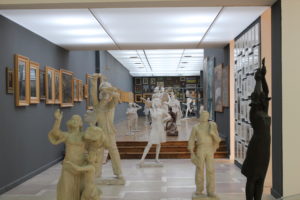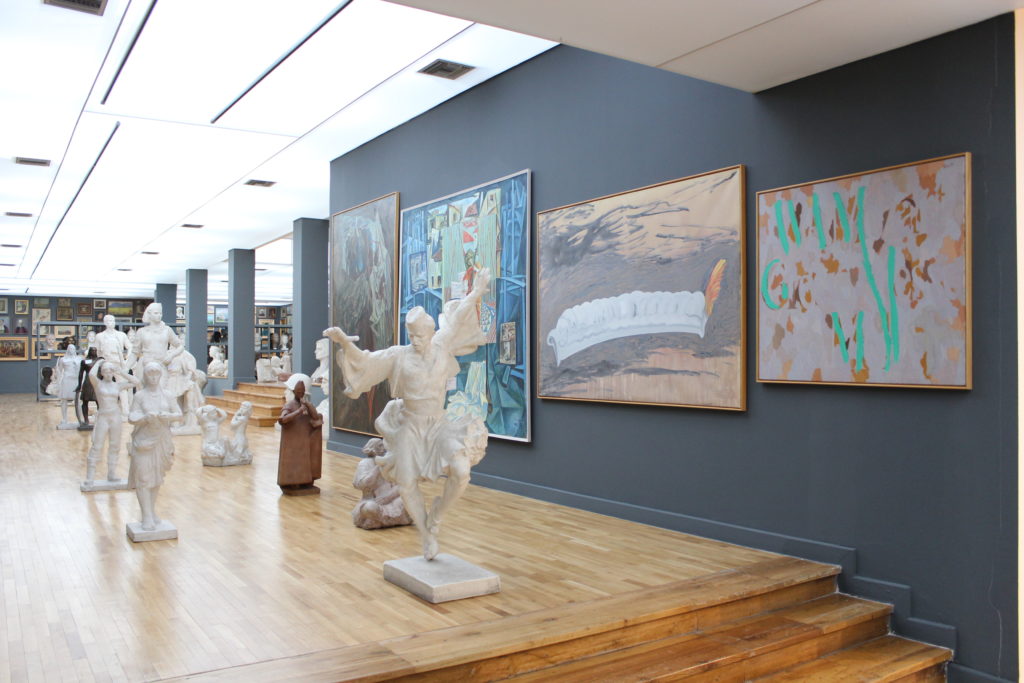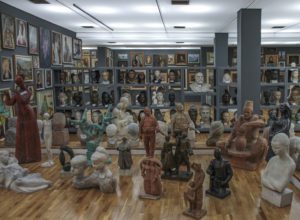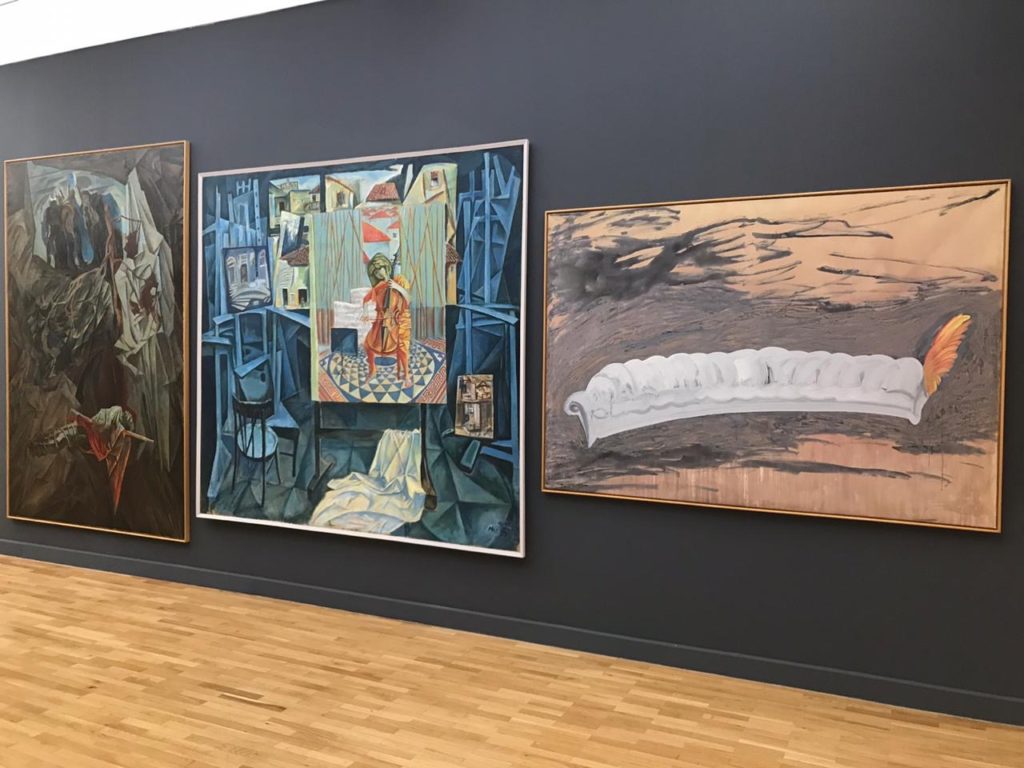Open Archive: A Review
Open Archive (Arkivi i Hapur), National Gallery of Arts, Tirana, September 18, 2020 – Ongoing.
The advent of the coronavirus pandemic seems to have sparked a surge in archival-minded exhibitions in museums (and other kinds of art spaces) the world over, a trend that was especially noticeable in the aftermath of the first wave of the pandemic during the summer of 2020. Many of these shows have been permeated by a sense of “getting back to basics,” as it were. This is not surprising, given that the coronavirus pandemic has put into question the ability of museums to perform the most basic of tasks, such as (physically) opening their doors to visitors, for example. This state of heightened precariousness has prompted an increased awareness of the museum’s fundamental functions, which are the preservation and exhibition of its permanent collection. In addition to the coronavirus pandemic, the renewed intensity of anti-colonial and anti-racist struggles in the United States and elsewhere around the globe has led to the permanent collections – and collecting practices – of museums being put under the microscope for reasons that are decidedly less flattering but that are, politically speaking, potentially much more productive.
This most recent “archival turn” brings to mind Claire Bishop’s call in Radical Museology, or What’s “Contemporary” in Museums of Contemporary Art for a (re)turn to the museum’s permanent collection and archive aimed at “reboot[ing] the future through the unexpected appearance of a relevant past.” As Bishop defines it, “radical museology” represents more than anything else a rejection of the temporality of disaster, of the way in which it dramatically contracts and compresses the lived experience of time. Thus, while Bishop’s essay was written largely in response to the fallout from the 2008 financial crisis, the latter is contextualized within the framework of a series of looming disasters, including nuclear war, terrorism, and climate catastrophe, that have the effect of “diminishing our ability to project into the future.” This explains the text’s present timeliness now that the threat of disaster has been realized. In turn, the idea of a “radical museology” can help us make sense of the degree to which the recent wave of archivally-minded exhibitions rise up to the task of imagining a radically different future in the face of global catastrophe.(Claire Bishop, Radical Museology, or What’s “Contemporary” in Museums of Contemporary Art (London: Koenig Books Ltd, 2013), pp. 59-61.)
As it happens, the last exhibition to open in Tirana’s National Gallery of Arts (Galeria Kombëtare e Arteve, or GKA) before the Covid-19 pandemic swept through Europe in the spring of 2020, Tirana Patience (curated by Nataša Ilić and Adam Szymczyk) as well as the first exhibition to open in the GKA following the (partial) lifting of quarantine measures in Albania in the summer of the same year, Open Archive (Arkivi i Hapur) curated by GKA director Erzen Shkololli, are both archivally-minded exhibitions focusing on the GKA’s permanent collection. What makes these exhibitions interesting for our discussion here is that they appear to showcase two completely different (some might even say opposed) approaches to the GKA’s permanent collection, approaches that were worked out against the backdrop of two separate but overlapping disasters. The disasters in question are the devastating M6.4 earthquake that struck Albania on November 26, 2019, and the Covid-19 pandemic which arrived in the country officially on March 9, 2020. Moreover, the exhibitions were affected by these disasters in strikingly asymmetrical ways.
Tirana Patience is a show that was nearly ravaged by disaster. The earthquake not only delayed the show’s opening, which was due to take place on November 27, 2019, but also left behind dramatic cracks in the walls of the GKA that are still prominently visible throughout the exhibition even though they have been repaired elsewhere inside the building. The decision to retain these “scars” in the exhibition can be read as an attempt to acknowledge the violent reality outside of the walls of the GKA and its ability to literally shatter those walls. The fact that these “scars” visually complement the appearance of the Socialist Realist paintings in the show that appear concealed behind delicate cotton veils helps here. This attempt must also be read, however, against the original curatorial position behind the act of (temporarily) withdrawing the Socialist Realist paintings from view. Namely, the idea that everything has been seen and said and done before, and its inadequacy (as revealed by the disaster) vis-à-vis the reality outside of the walls of the GKA (which was already a violent one, even before disaster struck). (“What can exhibitions do today? When everything is said and done and we have seen it all, what remains to be shown?”)(These questions are posed in the curatorial statement for Tirana Patience.) Because there is no doubt that the November 26, 2019, earthquake and shortly afterwards the outbreak of the Covid-19 pandemic, put to rest (at least temporarily) the notion that everything had been seen and said and done before.(And this is without taking into account the fact that the GKA’s permanent collection has certainly not been seen enough or talked about enough or researched enough.) We could say then that Tirana Patience marks a withdrawal from the quest for something like a “radical museology,” while also showing the price to be paid for that withdrawal.

Installation view of the Tirana Patience exhibition showing the damage caused by the earthquake on November 26, 2019. Photo by the author.
Open Archive, on the other hand, is an exhibition that was born in response to disaster, to both the November 26 earthquake which necessitated an evaluation of the condition of all the works in the GKA’s collection, and to the Covid-19 pandemic and the gaps it opened up in the GKA’s programming that obviously needed to be filled after the lifting of quarantine measures. Unlike Tirana Patience, Open Archive eschews an easily identifiable curatorial position that could potentially be undermined by some (other) unforeseen calamity. Similarly, instead of (temporarily) withdrawing the works in the GKA’s collection from view, Open Archive goes in the opposite direction by showing as many of them as possible at any given time. Finally, in Open Archive the world outside of the GKA’s walls is acknowledged in more indirect ways, such as through the inclusion in the exhibition of paintings and sculptures in the GKA’s collection slated for restoration, restoration work having been disrupted by the closure of the GKA during Albania’s draconian lockdown in the spring of 2020, and also by incorporating within the exhibition unmistakable signs of the (normally invisible) labor involved in installing it. Of course, “indirect” does not automatically mean less effective, just as “direct” does not automatically mean more effective. The question then is whether Open Archive fares any better than Tirana Patience when it comes to the quest for something like a “radical museology,” especially given its more advantageous positioning vis-à-vis the disaster(s).

Installation-in-progress of the display in Room 4 on the left and Room 3 on the right, as part of the Open Archive exhibition. Photo by the author.
At any given time, Open Archive comprises hundreds upon hundreds of artworks in a variety of media, all part of the permanent collection of the GKA. Paintings and sculptures feature heavily, as is to be expected, but there are also smaller displays of animations, ceramics, drawings, etchings, lithographs, and woodworks. The pieces on display date from the late nineteenth century to the late twentieth century, though for reasons that will become clear later it is difficult to give precise dates. I say “at any given time” because Open Archive is a constantly evolving exhibition – the artworks on display are subject to change, as is their configuration within the exhibition space. For instance, the display of caricatures that was previously located in the foyer on the ground floor of the GKA as well as the display of lithographs that was previously located inside the institution’s library, can now—at the time of writing—be found on view inside a newly opened exhibition area on the first floor of the GKA. Indeed, the exhibition space itself is constantly contracting, expanding, and generally shifting. To give an example, during the winter of 2020-21 Open Archive’s occupation of the GKA’s space extended to the building’s second floor, which as a result ended up being filled with (mostly) second-rate Socialist Realist paintings. However, it vacated this space only a few weeks later in order to make room for Ambitions (Synime), an exhibition of works by Albanian women artists. Generally speaking, however, the space of the GKA devoted to Open Archive has increased over time. The strategies used to achieve this have included: overtaking (in part or in whole) spaces designated for purposes other than the exhibition of artworks, such as the foyer, the shop, and the library; converting spaces that formerly functioned as storage rooms into exhibition rooms; and, as of the summer of 2021, sharing (or “invading”) the space of other exhibitions as well, specifically the Tirana Patience exhibition.

Display of Socialist Realist paintings mounted on semi-transparent brown panels from the Open Archive exhibition located inside the space of the Tirana Patience exhibition. Photo by the author.
All of the above can be explained by Open Archive’s overarching aim, which is to show as much of the GKA’s permanent collection as possible (ostensibly all of it) within the framework of a single exhibition, albeit one that does not seem to have a fixed end date. This appears to extend to elements of exhibition design from previous shows. Thus, the heavy industrial-type shelving units seen throughout Open Archive are a reference to the late Gëzim Qëndro’s tenure as director of the GKA, who devised this display for the institution’s socialist-era sculpture collection. The vitrines used for the drawing display in Room 1 on the ground floor of the GKA are an element of exhibition design recycled from the show dedicated to the Jan Dibbets collection that opened in early 2019. In a similar vein, the vitrines used to display the GKA’s collection of caricatures on the first floor of the GKA are an element of exhibition design recycled from the show dedicated to Kol Idromeno’s work that opened in mid-2019. Finally, the semi-transparent brown panels used to display Socialist Realist paintings in the foyer on the ground floor of the GKA, as well as inside the space of the Tirana Patience exhibition on the first floor of the GKA are an element of exhibition design recycled from the Ambitions exhibition in the spring of 2021. Still, this does not entirely explain the decision of the curatorial team behind Open Archive to pack the artworks so tightly that walking through the crammed space of the exhibition can feel overwhelming and even claustrophobic at times. This seems to have been done by design rather than being merely a consequence of the number of artworks on display. If the title of the exhibition is any indication, the intention behind subjecting the viewer of Open Archive to such a sensory (primarily visual) overload is to impress upon them the transparency and accessibility of the institution’s archive. (It is unclear what – if anything – the viewer is meant to do with this information, though.) From this point of view, Open Archive is part of a series of archive-centered shows that strive to create a shortcut between the exhibition of (communist-era) archives and their perceived readability.(For a discussion of these exhibitions see: Jonida Gashi, “Politics of Installation as Politics of the Archive: Three Case Studies,” Art Studies 19 (2020): pp. 121-137, http://iaksa.edu.al/en/art-studies-19/.)

View of Open Archive, Room 2 Entrance & Hallway. Photo by the author, February 2021.
These conditions make Open Archive a challenging exhibition to review, in the sense that ideally one would follow the exhibition closely throughout its run and faithfully register every change it undergoes. While the latter is perhaps an unrealistic proposition, the absence of a definitive list of works to which the viewer can refer when visiting Open Archive makes things more difficult than they need to be. It should be noted that during the first few months of the show’s run, a list of works was in fact made available to viewers. However, even then the sculpture display was not included in the list, ostensibly because the sculptural works had individual tags attached to them containing information about the title of the piece, the author, the year in which the work was produced. In reality, then as now, a great many sculptural works included in the show did not and still do not actually have any such tags. We could say then that the viewer of Open Archive is left to navigate the exhibition “blindly,” as it were, in spite of the overabundance of visual information. This also raises the question of whether there is a system in place for all the switching around and moving of artworks in Open Archive. This question takes on an added importance given that under the conditions of a pandemic repeat visitors are even more uncommon than usual, and also because even repeat visitors will miss changes in the exhibition given the sheer number of artworks involved. What is abundantly clear, however, is that even if there is a system in place it is one that has already been predetermined, with (repeat) visitors to the exhibition being tasked with merely figuring out the “riddle.” This represents a missed opportunity to encourage an increased sense of ownership of the GKA’s collection by the viewing public, a vital task at a time when Tirana’s – and Albania’s – main cultural institutions are being threatened with demolition by the Albanian government in order to make way for commercial development projects with little or no care for the architectural value of their buildings or the artistic values they inevitably embody.(Valentina di Liscia, “Open Letter Condemns the ‘Artwashing’ of Albanian Prime Minister’s Politics,” Hyperallergic, May 19, 2020, https://hyperallergic.com/565114/open-letter-condemns-artwashing-albania/.)

Installation view of Open Archive, Room 2 Entrance and Hallway. Photo by the author, February 2021.
The real problem with Open Archive, however, is that the technical and logistical feats involved in exhibiting the entirety of the GKA’s collection within a limited spatiotemporal framework are meant to function as substitutes for a proper curatorial position and process vis-à-vis that collection. The signs of the absence of a recognizable curatorial position and process are already visible in the eclecticism that characterizes the show, insofar as different parts of the exhibition are so to speak governed by different curatorial approaches. For instance, the painting display in Room 1 on the ground floor of the GKA demonstrates an engagement with genre (portraiture in this case) as organizing principle. A thematic approach, on the other hand, can be observed in the display of paintings above the imperial staircase leading to the first floor of the GKA (the theme in question being that of the National Antifascist Liberation War). Meanwhile, the small cluster of paintings in the narrow passageway on the first floor of the GKA that both connects and divides Open Archive to/from Tirana Patience demonstrates a concern with periodization, insofar as all of the works in question date from the second half of the 1960s and the 1970s, an epoch coinciding with the Albanian Ideological and Cultural Revolution that also represents a distinct phase in Albanian Socialist Realism. This eclecticism, or the rejection of a singular curatorial vision, comes across as a means of distracting from the fact that Open Archive makes no critical claim(s) about the GKA’s permanent collection, certainly not along the lines outlined at the outset of this review, which would involve searching among the ruins of history for the unique moment in the past that best corresponds to the present moment. Whereas our present moment is one of crisis (or, more accurately, crises) and rupture, Open Archive emphasizes precisely the opposite—namely, stability and continuity. Additionally, this is explicitly framed as a strategy for escaping from the present and, therefore, from the world outside of the GKA’s walls.(See: Erzen Shkololli, “Art në kohën e komunizmit” [“Art in the Time of Communism”], interview by Rudina Xhunga, Dritare: Shqiptarët e mrekullueshëm, November 1, 2020, https://dritare.net/ngjarjet-e-dites/art-ne-kohen-e-komunizmit-683 (accessed March 16, 2021); and Chris Keulemans, “Albanian Socialist Realism in the National Gallery of Arts, Tirana,” Kosovo 2.0, July 29, 2021, https://kosovotwopointzero.com/en/open-archive/ (accessed July 31, 2021).)
Founded in 1954, the GKA moved to its current location along the “Martyrs of the Nation” Boulevard some twenty years later, in November 1974. At the time of the move, the GKA’s collection was a modest one numbering under 350 works. The move, which was accompanied by internal restructuring, allowed the GKA to establish itself as the vanguard institution for the collection and exhibition of Albanian art from the second half of the nineteenth century to the present day, and grow its collection to an estimated 4,000 works. Nevertheless, the lion’s share of the GKA’s collection is made up of Socialist Realist art, something that is reflected in Open Archive to the extent that the majority of the artworks on display at any given time belong to the Socialist Realist “school.” Understandably, public discussion about the exhibition has also focused on the Socialist Realist artworks on show as well, specifically the dehistoricization and depoliticization of these works. In an interview promoting the exhibition, Erzen Shkololli admitted as much, describing his approach to the GKA’s Socialist Realist collection in the context of the Open Archive exhibition as one of putting the artist/artwork first in order to enable the appreciation and enjoyment of artworks that would otherwise be condemned and dismissed because of the epoch in which they were produced or the ideology to which they subscribe.(Erzen Shkololli, “Art në kohën e komunizmit.”) And, indeed, it is remarkable how seamlessly different artists, artworks, periods, styles, and themes blend into one other in Open Archive. Even where there is friction, it never feels dangerous or threatening. While this approach does not entirely erase the differences between distinct artists, artworks, periods, styles, and themes, it obfuscates the historical conditions that underpin them. As a result, visitors to Open Archive would be forgiven for thinking that the development of Albanian art from the late nineteenth century to the late twentieth century follows an unproblematic straight line. While this is far from being true, it raises a crucial question: whom does this narrative benefit, and what kind of agenda does it serve?(Zdenka Badovinac raised a similar point in her discussion of the protest against the destruction of the historic building of the Albanian National Theatre in the summer of 2020 by the Albanian government, ostensibly in the name of progress via architectural contemporaneity: “The Albanian case speaks to issues about art in relation to people’s right to the city and to its collective memory, which is a condition for reproducing any society. The artistic and civil actions in Tirana are not interested in the uninterrupted development of the national culture, or in its allegedly homogeneous unproblematic core, but rather in memory, which relies on various discontinuities.” Zdenka Badovinac, “Interdependence, or, Secrecy as the Last Universal Right,” e-flux Journal 110 (June 2020), https://www.e-flux.com/journal/110/336891/interdependence-or-secrecy-as-the-last-universal-right/.)

Installation view of Open Archive, with a view of Room 2 from the Imperial Staircase leading to the second floor of the GKA. Photo by the author, February 2021.
Open Archive’s now outdated (and unavailable) list of works that was mentioned earlier suggests a possible answer to this question. If someone who is relatively knowledgeable about the history of Albanian art, and Albanian painting in particular, consulted this list they would immediately pick up on the preoccupation with chronology and the canon in the display of paintings in the large exhibition hall on the ground floor of the GKA (Room 2). For instance, they would notice that some of the most well known paintings by some of the most well known Albanian painters through the years are included in this display. Additionally, they would note that both the earliest and most recent works in the exhibition overall are also included in this display, namely, Pjetër Marubi and Mikel Kodheli’s Nikoll Çoba Dressed in Traditional Costume from Shkodra (Nikoll Çoba me kostum shkodran, 1897) and Besim Tula’s The Tape (Kaseta, 1999). The latter practically face each other at the entrance/exit of Room 2, their placement code for the coming full circle of Albanian modern art history. This suggests another angle from which to approach the erasure of history, and specifically of socialist history, in Open Archive, which stages the post-socialist or contemporary period as the epoch of the birth of history. While this is not an uncommon position in present-day Albania, it is an inherently problematic one for many reasons, chief among them the fact that it has acted and continues to act as a foil for the more obscene excesses of the new age. The three paintings hanging next to Besim Tula’s The Tape highlight the way in which Open Archive sets out the post-socialist era to be the birth of art history in particular. They are Edi Rama’s The Sorrow of Kosovar Nights (Pikëllimi i netëve kosovare, 1989), Adrian Paci and Edi Muka’s Composition (Kompozim, 1989), and Edi Hila’s The Sofa (Poltroni, 1998). Together with Besim Tula’s The Tape, which appears diminutive next to them, these works form a cluster that is set apart from the rest of the painting display in Room 2 by virtue of having been hung on a separate wall section. (Fig. 6)

Edi Rama’s The Sorrow of Kosovar Nights (1989), Adrian Paci & Edi Muka’s Composition (1989), and Edi Hila’s The Sofa (1998).
The inclusion of these works dating from 1989 and 1998 in the cluster of paintings that conclude the display in Room 2 of the GKA, coupled with the decision to place them opposite the earliest works included in the exhibition as a whole, proclaims not only the birth of a new (artistic) era but also announces the individuals that ostensibly inaugurated, or represent, that era. Already many months ago, when the configuration of Open Archive matched its now outdated list of works, there were a dozen or so paintings from the very end of the 1980s and 1990s scattered throughout the exhibition. It is quite interesting then that the organizers of Open Archive selected a painting by Edi Rama, one by Rama’s former teacher (Edi Hila), and another by two of his former students (Adrian Paci and Edi Muka) to conclude the display in Room 2 of the GKA. It is also worth noting that while the overall display in Room 2 of the GKA has undergone many changes during the show’s run, the section that marks both the beginning and ending of the painting display in this space has remained unchanged, as of writing. This speaks to the way in which Open Archive functions as a vehicle for perpetuating a deeply entrenched and highly reactionary narrative that Tirana’s and Albania’s long-suffering art and cultural workers know only too well, a narrative that puts Albania’s current Prime Minister right at the center of the history of Albanian post-socialist and contemporary art from 1990 until the present. Edi Rama’s The Sorrow of Kosovar Nights hanging next to Adrian Paci and Edi Muka’s Composition and Edi Hila’s The Sofa performs the teleological trick upon which this narrative has relied and continues to rely in order to succeed. Namely, it effaces those elements – whatever they may be, i.e., individual artists, specific works of art, collective projects, etc. – that could challenge that narrative and the myth of its inevitability. This is another missed opportunity for Open Archive, the only positive aspect of which is the fact that it inadvertently speaks to the urgency of re-examining and rewriting Albanian contemporary art history.





